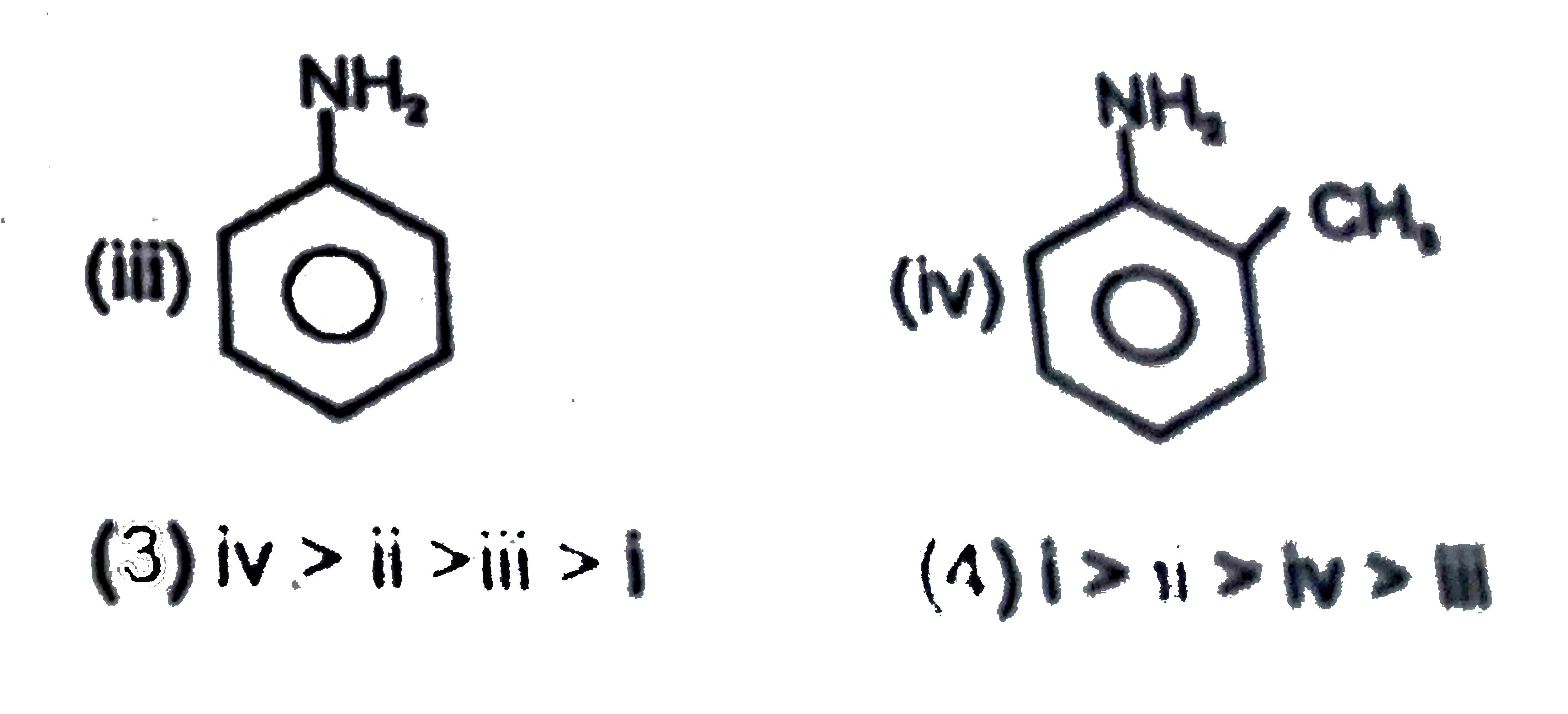Consider the following reactions of complex compounds A,B and C
(i) CoCl2Br⋅5NH3+excess Ag+(aq)→1AgCl(s)
(ii) CoCl2Br⋅5NH3Compound B+excess Ag+(aq)→2AgCl(s)
(iii) CoCl2Br⋅4NH3Compound C+excess Ag+(aq.)→1AgCl(s)
Then according to the given information the correct statement(s) is/are:
Compounds(A) and (B) are ionisation isomers
Molar conductivity of compounds (A) and (B) are almost same
Compounds (A), (B) and (C) do not exhibit geometrical isomerism
Order of CFSE values, Δ0(A)>Δ0(B)>Δ0(C)
The correct Answer is:A, B, D
To solve the problem, we need to analyze the reactions of the complex compounds A, B, and C and derive their structures based on the information provided. Let's break down the steps:
Step 1: Analyze Complex A
The reaction for complex A is:
CoCl2Br⋅5NH3+excess Ag+(aq)→1AgCl (s)
- Since only 1 mole of AgCl is formed, it indicates that only 1 chloride ion is outside the coordination sphere. The remaining chloride and bromide ions must be inside the coordination sphere.
- Therefore, the structure of complex A can be formulated as:
(Co(NH3)5Cl)2+Br−
Step 2: Analyze Complex B
The reaction for complex B is:
CoCl2Br⋅5NH3+excess Ag+(aq)→2AgCl (s)
- Here, 2 moles of AgCl are formed, indicating that there are 2 chloride ions outside the coordination sphere.
- Thus, the structure of complex B can be formulated as:
(Co(NH3)5Cl2)2+Br−
Step 3: Analyze Complex C
The reaction for complex C is:
CoCl2Br⋅4NH3+excess Ag+(aq)→1AgCl (s)
- Again, since only 1 mole of AgCl is formed, it indicates that there is 1 chloride ion outside the coordination sphere.
- Therefore, the structure of complex C can be formulated as:
(Co(NH3)4Cl)Br−
Step 4: Identify Relationships Between Compounds
1. Ionization Isomers: A and B are ionization isomers because they differ in the arrangement of chloride ions inside and outside the coordination sphere.
2. Molar Conductivity: Both A and B will dissociate into three ions in solution (1 complex ion + 2 halides), leading to similar molar conductivities.
3. Optical Isomerism: Complex C can exhibit geometrical isomerism due to the presence of different ligands (Cl and Br), while A and B do not show optical isomerism.
4. Crystal Field Stabilization Energy (CFSE): The CFSE will be higher for A than for B due to the stronger ligand (Cl) compared to Br, and C will have the lowest CFSE since it has fewer NH3 ligands.
Final Summary
Based on the analysis:
- Correct Statements:
- A and B are ionization isomers.
- Molar conductivity of A and B is similar.
- A and B do not show optical isomerism, but C can show geometrical isomerism.
- CFSE order: A > B > C.
The reaction for complex A is:
CoCl2Br⋅5NH3+excess Ag+(aq)→1AgCl (s)
- Therefore, the structure of complex A can be formulated as:
(Co(NH3)5Cl)2+Br−
The reaction for complex B is:
CoCl2Br⋅5NH3+excess Ag+(aq)→2AgCl (s)
- Thus, the structure of complex B can be formulated as:
(Co(NH3)5Cl2)2+Br−
The reaction for complex C is:
CoCl2Br⋅4NH3+excess Ag+(aq)→1AgCl (s)
- Therefore, the structure of complex C can be formulated as:
(Co(NH3)4Cl)Br−
1. Ionization Isomers: A and B are ionization isomers because they differ in the arrangement of chloride ions inside and outside the coordination sphere.
2. Molar Conductivity: Both A and B will dissociate into three ions in solution (1 complex ion + 2 halides), leading to similar molar conductivities.
3. Optical Isomerism: Complex C can exhibit geometrical isomerism due to the presence of different ligands (Cl and Br), while A and B do not show optical isomerism.
4. Crystal Field Stabilization Energy (CFSE): The CFSE will be higher for A than for B due to the stronger ligand (Cl) compared to Br, and C will have the lowest CFSE since it has fewer NH3 ligands.
Based on the analysis:
- Correct Statements:
- A and B are ionization isomers.
- Molar conductivity of A and B is similar.
- A and B do not show optical isomerism, but C can show geometrical isomerism.
- CFSE order: A > B > C.
Topper's Solved these Questions
- BOOK - VK JAISWAL ENGLISHCHAPTER - CO-ORDINATION COMPOUNDSEXERCISE - MATCH THE COLUMN36videos
CO-ORDINATION COMPOUNDS
- BOOK - VK JAISWAL ENGLISHCHAPTER - CO-ORDINATION COMPOUNDSEXERCISE - ASSERTION-REASON TYPE QUESTIONS26videos
CO-ORDINATION COMPOUNDS
- BOOK - VK JAISWAL ENGLISHCHAPTER - CO-ORDINATION COMPOUNDSEXERCISE - LEVEL 3 (PASSAGE TYPE)98videos
CO-ORDINATION COMPOUNDS
- BOOK - VK JAISWAL ENGLISHCHAPTER - CHEMICAL BONDING (BASIC)EXERCISE - SUBJECTIVE PROBLEMS54videos
CHEMICAL BONDING (BASIC)
- BOOK - VK JAISWAL ENGLISHCHAPTER - d-BLOCK ELEMENTSEXERCISE - ASSERTION-REASON TYPE QUESTIONS32videos
d-BLOCK ELEMENTS
Similar Questions
Which of the following is correct for both the following coordination compounds ?
(I)CoCl3.6NH3and (II)PtCl4.5NH3View SolutionConsider the following reactions,
Ax+yB2limited−−−−−−→supply of airCompound'P'+zB2−−−−→excess airCompound 'Q'
If atomic number of elements A and B are 15 and 8 respectively, then according to the given information the correct statement(s) is/are:View Solution
Knowledge Check
- Question 1 - Select One
Assertion : Aqueous solution of the compound CoCl3⋅4NH3 when treated with excess of AgNO3 , 1 mole of AgCl is precipitated .
Reason : The compound CoCl3⋅4NH3 has six primary valencies and one secondary valency .AIf both Assertion and reason are true and reason is the correct explanation of assertionBIf both assertion and reason are true but reason is not the correct explanation of assertionCIf assertion is true but reason is falseDif both assertion and reason are false
Which of the following is correct order of basic strength for the given compounds ?
(i)CH3−CH3−C−NH2∣∣NH (ii)CH3−C−CH3∣∣NH
 View Solution
View SolutionComplete and balance the following reaction.
(i)Na2S+CdCO3→ …..+…. , (ii)CoCl2+NH2SCNEther−−→ ….+….View SolutionComplete the following reactions:
(a) Cl2+F2(Equal volume)473K−−→ , (b)I2+3Cl2(Excess)→ (c )Br2+3F2→ (d)Br2+5F2(Excess)→View SolutionFor the following reaction Ag2SO4(s)⇋2Ag+(aq)+SO2−4(aq) More SO2−4 can be produced by
View SolutionComplete the following reactions:
2Me3C−−Br Ag2CO3−−−−→Δ (A)View SolutionR−NH2+CH3COClexcess→A.
The product (A) Will beView SolutionWhich of the following isomerism is/are shown by the complex [CoCl2(H2O)2(NH3)2] Br ?
View Solution

